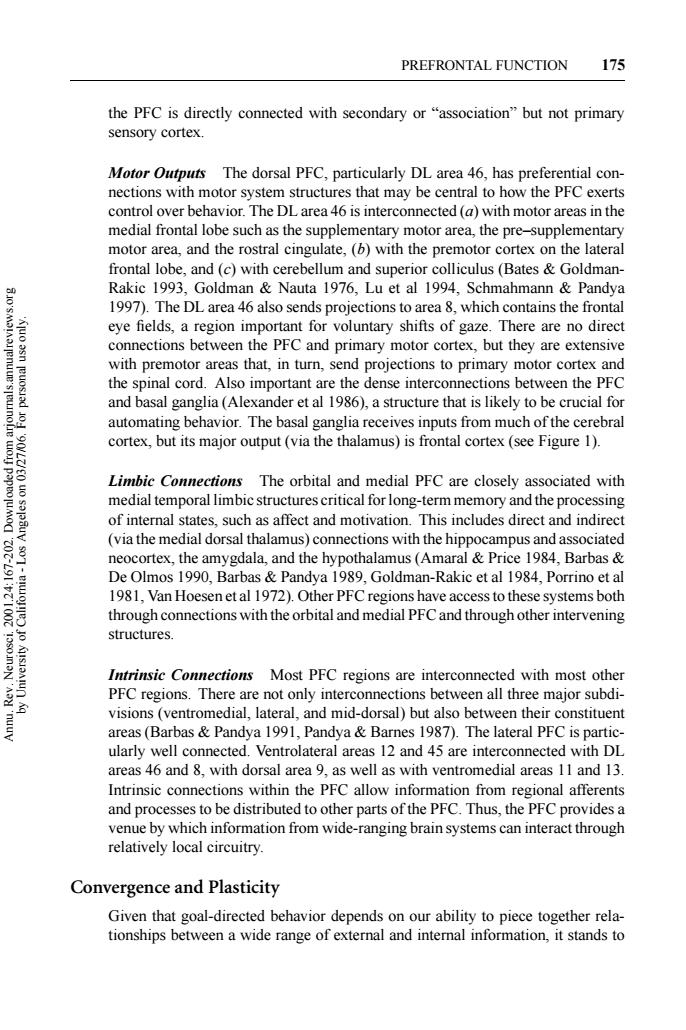正在加载图片...

PREFRONTAL FUNCTION 175 the PFC is directly connected with secondary or"association"but not primary sensory cortex. Motor Ouputs The dorsal PFC,particularly DL area 46,has preferential con nections with motor system structures that may be central to how the PFC exerts control over behavior.The DL area 46 is interconnected (a)with motor areas in the medial frontal lobe such as the supplementary motor area,the pre-supplementary motor area,and the rostral cingulate,(b)with the premotor cortex on the lateral and (c)with cerebellum olliculus(Bates&Goldm Rakic 193.GoldmanNauta 176.Lu.SchmahmannPandya 1997).The DL area 46 also sends projections to area 8,which contains the frontal eye fields,a region important for voluntary shifts of gaze.There are no direct connections between the PFC and primary motor cortex,but they are extensive with pre otor a eas that,in turn,send pr pjections to primary motor cortex and the spinal ord.Also mporant are the dense intercc be een the PFC and basal ganglia(Alexander et al 1986),a structure that is likely to be crucial for automating behavior.The basal ganglia receives inputs from much of the cerebral cortex,but its major output(via the thalamus)is frontal cortex(see Figure 1). Limbic Connections The orbital and medial PFC are closely associated with medial temporal limbic structures critical for long-term memory and the processing of internal states,such as affect and motivation.This includes direct and indirect (via the medial dorsal thalamus)connections with the hippocampus and associated ygdala,and theh P naral Price 1984.Barbas 990,Bar &Pandya 1989,Goldman-Rakic et al 1984,Porrino eta 1981,Van Hoesenetal 1972).Other PFCregions have access to these systems both through connections with the orbital and medial PFC and through other intervening structures. Intrinsic Connections Most PFC regions are interconnected with most other PFC regions.There are not only interconnections between all three major subdi- visions(ventromedial,lateral,and mid-dorsal)but also between their constituent areas (Barbas Pandva 1991 Pandva barnes 1987)The lateral pec is partic ularly well connected.Ventrolateral areas 12 and 45 are int nnected with DI well as with ventromedial areas and13 Intrinsic connections within the PFC allow information from regional afferents and processes to be distributed to other parts of the PFC.Thus,the PFC provides a venue by which information from wide-ranging brain systems can interact through relatively local circuitry Convergence and Plasticity Given that goal-directed behavior depends on our ability to piece together rela- tionships between a wide range of exte mal and internal information,it stands to P1: FXZ January 12, 2001 14:38 Annual Reviews AR121-07 PREFRONTAL FUNCTION 175 the PFC is directly connected with secondary or “association” but not primary sensory cortex. Motor Outputs The dorsal PFC, particularly DL area 46, has preferential connections with motor system structures that may be central to how the PFC exerts control over behavior. The DL area 46 is interconnected (a) with motor areas in the medial frontal lobe such as the supplementary motor area, the pre–supplementary motor area, and the rostral cingulate, (b) with the premotor cortex on the lateral frontal lobe, and (c) with cerebellum and superior colliculus (Bates & GoldmanRakic 1993, Goldman & Nauta 1976, Lu et al 1994, Schmahmann & Pandya 1997). The DL area 46 also sends projections to area 8, which contains the frontal eye fields, a region important for voluntary shifts of gaze. There are no direct connections between the PFC and primary motor cortex, but they are extensive with premotor areas that, in turn, send projections to primary motor cortex and the spinal cord. Also important are the dense interconnections between the PFC and basal ganglia (Alexander et al 1986), a structure that is likely to be crucial for automating behavior. The basal ganglia receives inputs from much of the cerebral cortex, but its major output (via the thalamus) is frontal cortex (see Figure 1). Limbic Connections The orbital and medial PFC are closely associated with medial temporal limbic structures critical for long-term memory and the processing of internal states, such as affect and motivation. This includes direct and indirect (via the medial dorsal thalamus) connections with the hippocampus and associated neocortex, the amygdala, and the hypothalamus (Amaral & Price 1984, Barbas & De Olmos 1990, Barbas & Pandya 1989, Goldman-Rakic et al 1984, Porrino et al 1981, Van Hoesen et al 1972). Other PFC regions have access to these systems both through connections with the orbital and medial PFC and through other intervening structures. Intrinsic Connections Most PFC regions are interconnected with most other PFC regions. There are not only interconnections between all three major subdivisions (ventromedial, lateral, and mid-dorsal) but also between their constituent areas (Barbas & Pandya 1991, Pandya & Barnes 1987). The lateral PFC is particularly well connected. Ventrolateral areas 12 and 45 are interconnected with DL areas 46 and 8, with dorsal area 9, as well as with ventromedial areas 11 and 13. Intrinsic connections within the PFC allow information from regional afferents and processes to be distributed to other parts of the PFC. Thus, the PFC provides a venue by which information from wide-ranging brain systems can interact through relatively local circuitry. Convergence and Plasticity Given that goal-directed behavior depends on our ability to piece together relationships between a wide range of external and internal information, it stands to Annu. Rev. Neurosci. 2001.24:167-202. Downloaded from arjournals.annualreviews.org by University of California - Los Angeles on 03/27/06. For personal use only